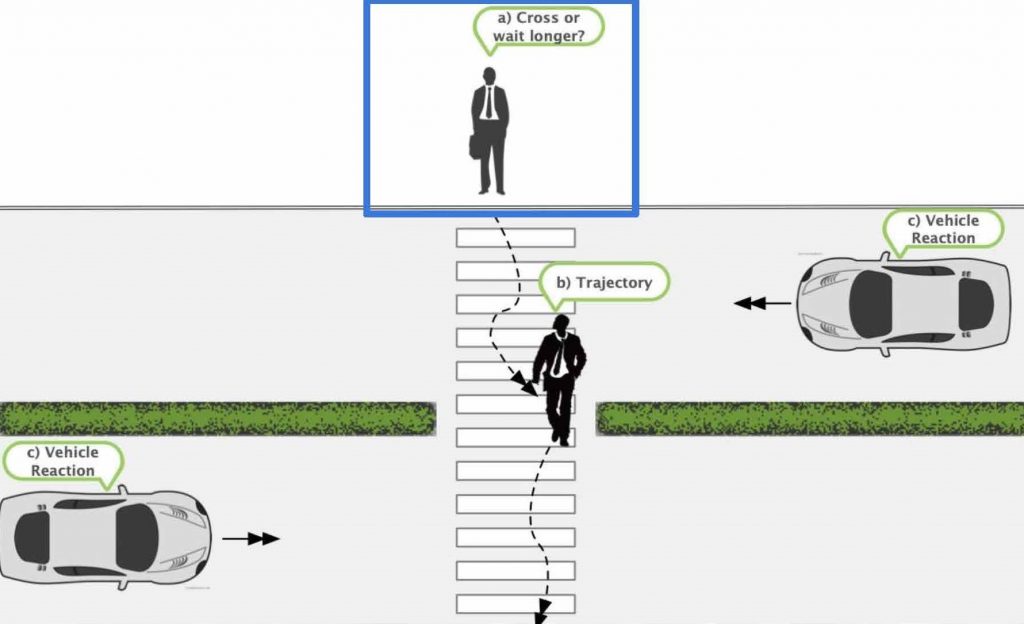Arash Kalatian, a PhD student at Ryerson University, gave a presentation on “Decoding pedestrian and automated vehicle interactions using immersive virtual reality and interpretable deep learning” on February 28, 2020.
The evolution of AVs is a highly debatable topic in the transportation industry. Most researchers and academics argue that the future is AV and our streets should be primed with infrastructure that support it. Among all the road users, pedestrians are considered the most vulnerable.

The presentation was the summary of an ongoing project done by Kalatian and his team at Ryerson University, who created a virtual experiment where they interacted with variety of participants to react to a virtual traffic environment. His team suggested neural networks over Linea Survival methods for adapting the results. The data collection included 180 participants over 5 months; mainly students, the general public, professionals familiar with city issues, and two groups of 10- and 15-year-olds.
Towards the end of the seminar, Kalatian presented the concerns that derived from the experiment. Some of them are:
- Conservative nature of the participants regarding AVs (e.g. need for nationwide educational programs to familiarize people with AVs)
- Promoting active modes and developing more pedestrian friendly infrastructure
- Attention to children and senior participants
Kalatian concluded by noting the impact of the pedestrian perspective on AVs, and the importance of advanced data-driven models that will improve the performance. He also touched on the prospective future projects that the team plans to work on.
For further details please see Kalatian’s presentation file: Decoding pedestrian and automated vehicle interactions using immersive virtual reality and interpretable deep learning by Arash Kalatian and Bilaal Farooq.
Abstract
To ensure pedestrian friendly streets in the era of automated vehicles, reassessment of current policies, practices, design, rules and regulations of urban areas is of importance. This study investigates pedestrian crossing behaviour, as an important element of urban dynamics that is expected to be affected by the presence of automated vehicles. For this purpose, an interpretable machine learning framework is proposed to explore factors affecting pedestrians’ wait time before crossing mid-block crosswalks in the presence of automated vehicles. To collect rich behavioural data, we developed a dynamic and immersive virtual reality experiment, with 180 participants from a heterogeneous population in four different locations in the Greater Toronto Area (GTA). Pedestrian wait time behaviour is then analyzed using a data-driven Cox Proportional Hazards (CPH) model, in which the linear combination of the covariates is replaced by a flexible non-linear deep neural network. The proposed model achieved a 5% improvement in goodness of fit, but more importantly, enabled us to incorporate a richer set of covariates. A game theoretic based interpretability method is used to understand the contribution of different covariates to the time pedestrians wait before crossing. Results show that the presence of automated vehicles on roads, wider lane widths, high density on roads, limited sight distance, and lack of walking habits are the main contributing factors to longer wait times. Our study suggested that, to move towards pedestrian-friendly urban areas, national level educational programs for children, enhanced safety measures for seniors, promotion of active modes of transportation, and revised traffic rules and regulations should be considered.
 Arash Kalatian is a PhD Candidate in the Transportation Engineering program at Ryerson University, Toronto. He received his BSc in Civil Engineering and MSc in Transportation Planning, both from Sharif University of Technology, Iran. He started his PhD in 2017 under supervision of Dr. Bilal Farooq. Arash’s research mainly focuses on Cyber-Physical Transportation Systems, i.e. Virtual Reality and Ubiquitous Networks, and more specifically, their application in studying Pedestrian Behaviours and Movement Dynamics.
Arash Kalatian is a PhD Candidate in the Transportation Engineering program at Ryerson University, Toronto. He received his BSc in Civil Engineering and MSc in Transportation Planning, both from Sharif University of Technology, Iran. He started his PhD in 2017 under supervision of Dr. Bilal Farooq. Arash’s research mainly focuses on Cyber-Physical Transportation Systems, i.e. Virtual Reality and Ubiquitous Networks, and more specifically, their application in studying Pedestrian Behaviours and Movement Dynamics.
Presented by University of Toronto ITE Student Chapter, UT-ITE.
